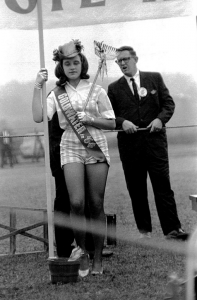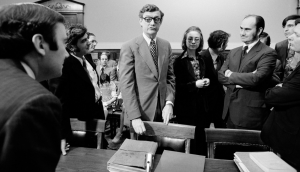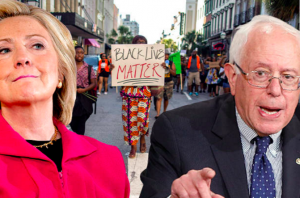 aNewDomain — Thomas Frank made a splash a decade ago with a bestseller called What’s the Matter With Kansas? In his book, Frank tried to answer the question: Why do so many working-class Americans vote against their economic and social interests — i.e., Republican?
aNewDomain — Thomas Frank made a splash a decade ago with a bestseller called What’s the Matter With Kansas? In his book, Frank tried to answer the question: Why do so many working-class Americans vote against their economic and social interests — i.e., Republican?
I’ve been thinking about Frank a lot lately. Beginning with the Southern states on Super Tuesday and continuing through Tuesday’s important New York primary, the critical support of black voters has created a “firewall” for Hillary Clinton against the insurgent candidacy of Bernie Sanders in the Democratic race for president.
Yet Sanders is far more liberal than Clinton, and has a far better record on black issues than she does.
What’s going on?
Why are so many African Americans voting against their own interests — i.e., for a Democrat in Name Only?
Sanders, the liberal radical, in the race, carries white states. Clinton, the conservative incrementalist, carries those that are more ethnically diverse.
 And in New York this week, the pattern continued. (Forget evidence that Clintonista-Cuomoite henchmen stole the primary, that’s another story).
And in New York this week, the pattern continued. (Forget evidence that Clintonista-Cuomoite henchmen stole the primary, that’s another story).
According to exit polls, Hillary carried 75 percent of African-Americans in New York, but just 49 percent of whites. It’s uncomfortable for liberals to talk about, so hardly anyone is. But the data is clear on this:
There is a glaring racial divide within the Democratic Party.
This appears to be a new development.
The whole thing reminds me of what happened in my upper Manhattan neighborhood in November 1984. The city’s Democratic Party put up posters all over the place, thanking us for voting Walter Mondale in favor of Ronald Reagan, and at the highest rate in the United States.
Then as now, the area was diverse: The so-called Manhattan Valley neighborhood, where I lived, remains dominantly Latino, with many blacks and, due to nascent gentrification, a growing white presence.
But all of us — including young white people like me, young people of color, middle-aged people of color, old people of color — were on the same page politically: That is, as far left as allowed by law.
If there’d been a Bernie Sanders on the ballot in 1984, he would have gotten 99 percent of Manhattan Valley and beaten Mondale hands down.
It’s hard to tell when or how or why, but things have changed dramatically in the past 32 years. Not since George McGovern in 1972 has Democratic Party politics seen any major candidate as far left or as progressive as Bernie Sanders, even including insurgent liberals like Howard Dean and John Edwards.
 But only now is it possible to perceive a widening race gap in Democratic politics.
But only now is it possible to perceive a widening race gap in Democratic politics.
You have to wonder what is up with this. Because, on its face, this is a trend that makes little sense.
More and more I hear Sanders’ supporters paraphrasing Thomas Frank: They also want to know what is the matter with black voters?
On racial justice issues, after all, Bernie is a zillion times better than Hillary.
And overall, if the Democratic primary campaign were based on the issues and the candidates’ personal histories, we’d expect blacks to be a key voting bloc for Bernie, not Hillary.
During the Civil Rights movement in 1963, Bernie Sanders got arrested to protest housing segregation and traveled to the March on Washington to hear Dr. Martin Luther King speak. Meanwhile, Hillary Clinton spent the year as an “active young Republican and, later, a Goldwater girl.” Barry Goldwater, recall, voted against the Civil Rights Act, and Hillary now claims that she never actually voted for Goldwater. But the comparison remains.
Throughout his political career, Sanders has consistently championed racial equality and fought poverty and income disparity, two economic scourges that hurt blacks worse than anyone else.
But, as First Lady, Clinton pushed hard for her husband’s 1994 crime bill, which accelerated mass incarceration of blacks. Though she and Bill now admit it went too far, neither have proposed actually doing something to fix it, like letting those sentenced under the law out of prison, for example.
 Hillary Clinton also has backed so-called welfare reform, which drastically increased extreme poverty, especially among blacks.
Hillary Clinton also has backed so-called welfare reform, which drastically increased extreme poverty, especially among blacks.
And, while running for president in 2008, Hillary was the only candidate who said she wouldn’t end the crack and powder cocaine sentencing disparity.
Bottom line: Hillary Clinton is essentially a Republican.
And since when do blacks vote Republican?
One possible answer to this puzzle is name recognition. Hillary Clinton has been a boldface name in politics since 1993. As recently as September, 38 percent of all Americans had never heard of Bernie Sanders.
But that still doesn’t explain the race gap we are seeing now. After all, Sanders was an obscure figure to the majority of American voters, white and black alike.
Another factor is class. Influenced by Marx, Old Left Democrats like Sanders see racism, sexism and other forms of oppression as subsets of class warfare by ruling elites against the rest of us. But today’s Democrats abandoned class analysis long ago. Now, they’re all about identity politics.
 So, even though she’s wealthy, Hillary Clinton is now seen by identity politics devotees as a victim of oppression. Just because she’s a woman.
So, even though she’s wealthy, Hillary Clinton is now seen by identity politics devotees as a victim of oppression. Just because she’s a woman.
But even though he is Jewish and squarely middle-class, the same identitarians write off Bernie Sanders as just another privileged white male.
Maybe that is why some black voters relate to her more than the old guy.
Another answer might lie in the ugly zone, so ugly that many of us on the left don’t like to discuss it: black anti-Semitism. According to Anti-Defamation League surveys, anti-Semitism is significantly more widespread among African-American and Latino voters than the population as a whole. Some black voters may be holding Bernie’s Jewishness against him.
Ageism may play a role too: In part thanks to obvious plastic surgery, Hillary, 68, looks younger than Bernie, 74.
But are blacks more ageist than white millennials? That seems unlikely.
All of this, of course, is just interesting speculation. And if you look at just what we know about how Democrats chose their candidates in New York this week, still another explanation emerges. This week, Hillary voters told pollsters that they had the following priorities: experience, electability (though Bernie is actually more electable) and the continuation Obama’s policies.
Bernie voters, on the other hand, said the factors they cared most about were honesty and trustworthiness, and policies more liberal than Obama’s.
As you see, there’s a lot more than a whiff of the identity politics explanation there.
In his presidency, Obama has been so weak on racial issues. Understandably, many black voters nevertheless value his historical import as the first black president. And they remain loyal to him, despite his inaction on things that matter to them.
And Hillary was, of course, Obama’s secretary of state. She invokes him all the time.
The (false) belief that Hillary is more electable than Bernie is, I think, the most underappreciated factor driving black support for her and away from Bernie. Consider: The Rev. Al Sharpton ran for president in 2004. After he got trounced in the South Carolina primary, people wondered why a state with so many blacks delivered so few votes for the one black candidate in the race.
One answer was instructive:
“The black vote is looking for a winner and they are not looking to make a statement about race. John Kerry is one of the whitest guys, you know what I mean,” David Bositis, an analyst with the Joint Center for Political and Economic Studies in Washington, told The New York Times at the time. For blacks, beating Bush was job one.
There was no job two.
And recently Times columnist Charles M. Blow made a similar point, that in order to survive blacks (especially in the South) have had to be cautious.
Black voters think Hillary is better known and thus, in their opinion, more electable.
This year, black Democrats may be trying to make a statement about race, while being cautious.
What they are really doing, in their caution, is increasing the chances of a victory by Donald Trump.
For aNewDomain and the new Skewed News, I’m Ted Rall.
Cover: Slate.com, All Rights Reserved.
1963 Photo of Bernie Sanders being arrested during a Civil Rights march: The Chicago Tribune archive, All Rights Reserved. Photoshopped image of Clinton and Sanders with a Black Lives Matter image behind them: FreeRepublic.com, All Rights Reserved. Image of Hillary Clinton with John Doar, bringing charges against Richard Nixon in 1972: David Hume Kennerly, All Rights Reserved. Image of Hillary Clinton in 1964: CapeCentralHigh.com, All Rights Reserved.













